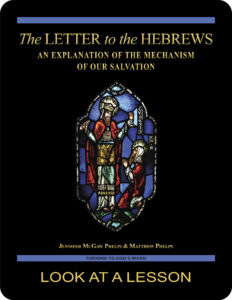beset by weakness
 The Letter to the Hebrews 5:2–3 (NABRE) presents a powerful and potentially problematic view of Jesus—”for he himself is beset by weakness, and so, for this reason, must make sin offerings for himself as well as for the people.” The implication of this passage seems to be that Jesus experiences some form or effect of sin, which is contrary to other teaching about Jesus.
The Letter to the Hebrews 5:2–3 (NABRE) presents a powerful and potentially problematic view of Jesus—”for he himself is beset by weakness, and so, for this reason, must make sin offerings for himself as well as for the people.” The implication of this passage seems to be that Jesus experiences some form or effect of sin, which is contrary to other teaching about Jesus.
The Greek word translated as “beset,” περίκειμαι (perikeimai), is a precise term that literally means “to lie around” and more abstractly “to be around someone.” So the sin and weakness referenced in this passage aren’t in or part of Jesus. They are all around him. Everywhere Jesus went while on earth, he was surrounded by weakness and sin on all sides. In fact, Jesus, though God, also was himself a human being. Although Jesus didn’t sin as other people do, that doesn’t mean he didn’t share our temptations and weaknesses. While in human form on earth, Jesus was quite literally surrounded by that weakness since he took it with himself everywhere he went—though he did not give in to that weakness.
This sharing in our human frailty and struggle gives Jesus a strong ability to have mercy and compassion for men and woman. Jesus is familiar with our struggles and sufferings, and through his sharing in them, he has provided us with a means of victory over those weaknesses and the ability to inherit eternal life. This is the priesthood to which the Father called him. In Christ, we find forgiveness of our sins and reconciliation with God.
you also may like our study of the Letter to the Hebrews (digital only)
 Many Christians struggle to understand one of the central mysteries of our faith: how Jesus can be both human and divine at the same time. The Letter to the Hebrews: An Explanation of the Mechanism of Our Salvation, an 18-lesson Catholic Bible study with an imprimatur, offers an in-depth look at the way in which Jesus’ dual nature allows for the salvation of humanity. The Letter to the Hebrews is designed to provide information that will encourage Christians to remain faithful. Click on the book’s cover to view a sample lesson.
Many Christians struggle to understand one of the central mysteries of our faith: how Jesus can be both human and divine at the same time. The Letter to the Hebrews: An Explanation of the Mechanism of Our Salvation, an 18-lesson Catholic Bible study with an imprimatur, offers an in-depth look at the way in which Jesus’ dual nature allows for the salvation of humanity. The Letter to the Hebrews is designed to provide information that will encourage Christians to remain faithful. Click on the book’s cover to view a sample lesson.
 Click on the picture of the statue of Moses with horns (above) to learn more about Lost in Translation. A new entry is archived each Monday. Contact us to receive Lost in Translation by email every week. You may use any of the contact links on our website to ask Matthew a question.
Click on the picture of the statue of Moses with horns (above) to learn more about Lost in Translation. A new entry is archived each Monday. Contact us to receive Lost in Translation by email every week. You may use any of the contact links on our website to ask Matthew a question.
